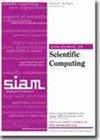三维精确无发散有限元空间的尺寸
IF 2.6
2区 数学
Q1 MATHEMATICS, APPLIED
引用次数: 0
摘要
SIAM 科学计算期刊》,第 46 卷第 2 期,第 A1102-A1131 页,2024 年 4 月。 摘要。我们研究了具有精确发散约束的三维四面体网格上各种 inf-sup stable 混合有限元空间的尺寸。更确切地说,我们比较了高多项式度的标准斯科特-沃格利乌斯元素和分裂网格、Alfeld 和 Worsey-Farin 分裂网格上的低阶方法。主要工具是一种计数策略,只用几个网格量来表示给定多项式度和给定分割的自由度,并研究网格细化下的边界和渐近行为。此外,我们还利用这一点来深入了解斯托克斯复数中的潜在前导空间,以便在沃西-法林分割上使用有限元方法。计算结果的可重复性。本文被授予 "SIAM 可重复性徽章":代码和数据可用",以表彰作者遵循了 SISC 和科学计算界重视的可重现性原则。读者可以通过 https://git-ce.rwth-aachen.de/pub/meshquantities/ 和补充材料(meshquantities-main.zip [3.13KB])中的代码和数据重现本文的结果。本文章由计算机程序翻译,如有差异,请以英文原文为准。
Dimensions of Exactly Divergence-Free Finite Element Spaces in 3D
SIAM Journal on Scientific Computing, Volume 46, Issue 2, Page A1102-A1131, April 2024.
Abstract. We examine the dimensions of various inf-sup stable mixed finite element spaces on tetrahedral meshes in three dimensions with exact divergence constraints. More precisely, we compare the standard Scott–Vogelius elements of higher polynomial degree and low-order methods on split meshes, the Alfeld and the Worsey–Farin split. The main tool is a counting strategy to express the degrees of freedom for given polynomial degree and given split in terms of only a few mesh quantities, for which bounds and asymptotic behavior under mesh refinement is investigated. Furthermore, this is used to obtain insights on potential precursor spaces in the Stokes complex for finite element methods on the Worsey–Farin split. Reproducibility of computational results. This paper has been awarded the “SIAM Reproducibility Badge: Code and data available” as a recognition that the authors have followed reproducibility principles valued by SISC and the scientific computing community. Code and data that allow readers to reproduce the results in this paper are available at https://git-ce.rwth-aachen.de/pub/meshquantities/ and in the supplementary materials (meshquantities-main.zip [3.13KB]).
Abstract. We examine the dimensions of various inf-sup stable mixed finite element spaces on tetrahedral meshes in three dimensions with exact divergence constraints. More precisely, we compare the standard Scott–Vogelius elements of higher polynomial degree and low-order methods on split meshes, the Alfeld and the Worsey–Farin split. The main tool is a counting strategy to express the degrees of freedom for given polynomial degree and given split in terms of only a few mesh quantities, for which bounds and asymptotic behavior under mesh refinement is investigated. Furthermore, this is used to obtain insights on potential precursor spaces in the Stokes complex for finite element methods on the Worsey–Farin split. Reproducibility of computational results. This paper has been awarded the “SIAM Reproducibility Badge: Code and data available” as a recognition that the authors have followed reproducibility principles valued by SISC and the scientific computing community. Code and data that allow readers to reproduce the results in this paper are available at https://git-ce.rwth-aachen.de/pub/meshquantities/ and in the supplementary materials (meshquantities-main.zip [3.13KB]).
求助全文
通过发布文献求助,成功后即可免费获取论文全文。
去求助
来源期刊
CiteScore
5.50
自引率
3.20%
发文量
209
审稿时长
1 months
期刊介绍:
The purpose of SIAM Journal on Scientific Computing (SISC) is to advance computational methods for solving scientific and engineering problems.
SISC papers are classified into three categories:
1. Methods and Algorithms for Scientific Computing: Papers in this category may include theoretical analysis, provided that the relevance to applications in science and engineering is demonstrated. They should contain meaningful computational results and theoretical results or strong heuristics supporting the performance of new algorithms.
2. Computational Methods in Science and Engineering: Papers in this section will typically describe novel methodologies for solving a specific problem in computational science or engineering. They should contain enough information about the application to orient other computational scientists but should omit details of interest mainly to the applications specialist.
3. Software and High-Performance Computing: Papers in this category should concern the novel design and development of computational methods and high-quality software, parallel algorithms, high-performance computing issues, new architectures, data analysis, or visualization. The primary focus should be on computational methods that have potentially large impact for an important class of scientific or engineering problems.

 求助内容:
求助内容: 应助结果提醒方式:
应助结果提醒方式:


